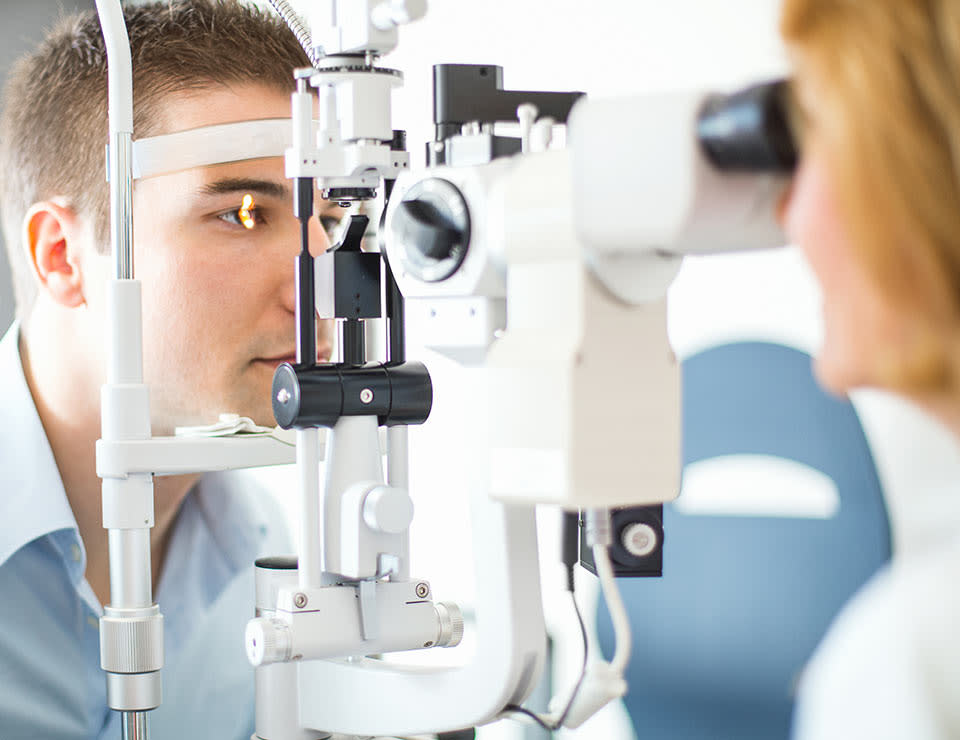Don't lose sight of what's important
Are you over 40? You may have eye disease and not even know it
Eye disease doesn’t discriminate. It can happen to anyone of any age and if not detected or treated early, the consequences can be serious and permanent.
As we get older and the likelihood of age-related eye conditions increases, the need for regular eye tests becomes even more critical. Because many eye diseases will show no early symptoms. Once symptoms do appear, it can often be too late.
If you’re aged 50 and over, it is important to have an eye test every two years. If you have a family history of eye disease such as glaucoma, regular eye tests should begin from the age of 40.

Ready to connect with your local eye health expert?
As Australia’s biggest optometry booking platform, EyeHealth1st makes finding and booking an eye test with your local eye health expert fast and convenient. Book your appointment on the go, when it suits you and keep sight of what's important.

The facts that matter
Every year, more than 10,000 people lose their sight due to eye disease. Ninety per cent of these cases could have been prevented if they’d been detected early.
EyeHealth1st is committed to making eye tests a regular and essential part of every person’s healthcare routine and preventable blindness a thing of the past. Just like the importance of regular checkups with your dentist and GP, regular visits to your local optometry expert will help to identify any issues early so you can maintain your eye health now and into the future.
Don’t wait until it’s too late. Book an eye test online today.
Your optometry appointment explained
There are different types of eye tests (sometimes called eye exams) depending on your needs. We recommend requesting a comprehensive check before or when you arrive for your appointment. This will involve your optometrist checking your eyesight as well as testing for serious eye diseases that cannot be detected without professional examination. Many eye conditions don’t have any visible symptoms in their early stages and this is the most critical time for detection and treatment. Here’s what you can expect from a full eye health test.
Pre-test
When you arrive for your eye test, your optometrist may ask about your personal, medical and family history, as well as other questions about your lifestyle. This ensures they have the information they need to provide you with the best possible care, advice and treatment on your eye health. Before starting, be sure to ask your optometrist what tests they are going to perform and any other questions you may have.
The eye test
Because every optometry practice is different, the length of your appointment will vary but most are generally between 30 to 60 minutes. Once your optometrist knows your history, they will customise your eye test for what is important and appropriate for your eyes. They will test for any refractive error (blurring of your vision) and/or the possibility that your eyes are fatiguing because of any kind of eye strain.
Your optometrist will also check your eyes for any evidence of eye disease. Most examinations will test for glaucoma, macular degeneration, cataracts, and dry eye diseases. If you have diabetes, your optometrist will likely check for any damage the condition is causing to your eyes. If any symptoms or conditions are identified, your optometrist may elect to monitor and review them if they are in the early stages, or refer you to an ophthalmologist (eye surgeon) to investigate treatment.
Things to ask
Don’t be afraid to ask questions, both during the test and afterwards. Some suggested questions include: Am I at risk for developing an eye disease?; Is there anything I can do to reduce my risk of eye disease?; How do I monitor my eye health?; How often should I get an eye test?. We also recommend you have your optometrist provide you with a full report of the tests that were done and the results.
Who is at risk of eye disease?
Eye disease doesn’t discriminate and can affect anyone throughout their lifetime. However, there are certain factors that can increase your chance of developing eye disease and eye conditions. These include age, a family history of eye disease, diabetes, smoking, unhealthy diet, high blood pressure, high cholesterol, long-term eye exposure to sunlight. To learn more and find out if you’re at risk, book an appointment with your local eye health expert.

Common eye conditions
There are five eye conditions that are responsible for close to 90 per cent of blindness and vision impairment in Australia. When you have an eye test the optometrist will test for some or all of these, depending on your age, medical history and other individual factors.
Glaucoma
What is it?
Glaucoma is an eye disease that causes damage to the optic nerve. Sometimes referred to as the silent thief of sight, glaucoma commonly has no symptoms or pain in its earliest stages. Slowly the disease will cause irreparable damage to your eyes, all before you even know you have it. More than 300,000 people in Australia are affected by glaucoma. Half of them don’t realise they are affected.
Who is at risk?
If you are aged over 50, you are at a greater risk of developing glaucoma. If you have a family history or are of African or Asian descent, the risk is even higher. Other risk factors include but are not limited to diabetes, high or low blood pressure, are short or long sighted, and have had an eye injury. To find out more, we recommend booking an appointment with your local optometrist.
Can it be treated or cured?
Eye tests are the only ways to identify glaucoma in its early stages. With early detection and intervention, glaucoma can be managed and treated to slow progression and reduce vision loss. If caught early enough, damage to your eyesight is often treated with prescribed eye drops. In later stages, operations on your eye may be needed to save your sight. However, there is currently no cure for glaucoma.
Age-related macular disease
What is it?
Age-related macular disease causes damage to the macula, the part of the eye needed for central vision and seeing straight ahead.
Who is most at risk?
Age-related macular disease can affect anyone in their lifetime but age is the number one risk factor. Age-related macular degeneration is the leading cause of blindness and low vision in Australians aged over 40. Others at risk include smokers, people with a family history, and people who are overweight or obese.
Can it be treated or cured?
There is currently no cure for age-related macular disease. However, with early detection and treatment, some versions of this condition can be managed. Treatments available in some circumstances include injections into your retina, and other surgery may be needed to reduce further loss of vision in some circumstances.
Cataracts
What is it?
A cataract is the clouding of the clear lens in the eye.
Who is at risk?
While cataracts can develop at any age, people who are most at risk at those over 40. This risk vastly increases as you age. Others at risk include those with a family history of cataracts, people with diabetes, smokers, and people whose eyes have been exposed to sunlight without protection for a protracted period of time.
Can it be treated or cured?
The good news is cataracts can be treated. In its early stages, vision may be improved with stronger glasses or other visual support aids from your local eye health expert. When cataracts are more advanced, surgery may be required. Cataract surgery is usually very successful, and in many occasions can even make you much less reliant on your glasses.
Diabetic retinopathy
What is it?
Diabetic retinopathy occurs when the blood vessels inside the retina at the back of the eye are damaged as a result of diabetes and chronic high blood glucose. As diabetes is the fastest growing chronic condition in Australia, the number of people impacted by this condition is only set to increase.
Who is most at risk?
If you have diabetes, you are at risk of developing diabetic retinopathy, particularly if you’ve had diabetes for a long time. It is important to maintain a healthy lifestyle because other factors such as high blood pressure, smoking, and consistently unstable sugar levels can increase your chances of developing the condition.
Can it be treated or cured?
Eye surgery and laser procedures can help to slow the progression of retinopathy and decrease a person’s risk of blindness. Early intervention is key. If you have diabetes, it is recommended you get eye tests every one or two years to monitor and maintain your eye health.
Uncorrected refractive error
What is it?
Refractive error is a very common eye condition and occurs when the eye cannot clearly focus. There are several types of refractive error, with the main ones being myopia (nearsightedness), hyperopia (farsightedness), presbyopia (loss of near vision with age), and astigmatism. If left untreated it can lead to significant vision loss or blindness. Uncorrected refractive error is still one of the leading causes of vision loss in Australia.
Who is most at risk?
Refractive error can happen to anyone at any age. People with a family history of refractive error are more at risk. The risk of developing presbyopia increase after the age of 40.
Can it be treated or cured?
Refractive error can be treated with glasses or contact lenses prescribed by your local eye health expert. A comprehensive eye exam is recommended to ensure the prescription is correct for you and that there is no eye disease behind your vision changes. Laser surgery can also correct refractive error.
Find your local independent eye health expert and book your appointment today
Book nowReferences
Vision 2020. (2016). Avoidable Blindness and Vision Loss. Retrieved January 2019.
Vision Initiative. (2019). Eye health in Australia. Retrieved February 2019.
Vision Initiative. (2019). Eye health in Australia. Retrieved February 2019.



